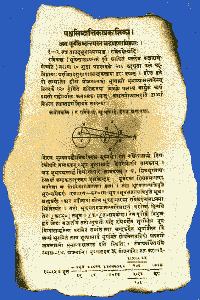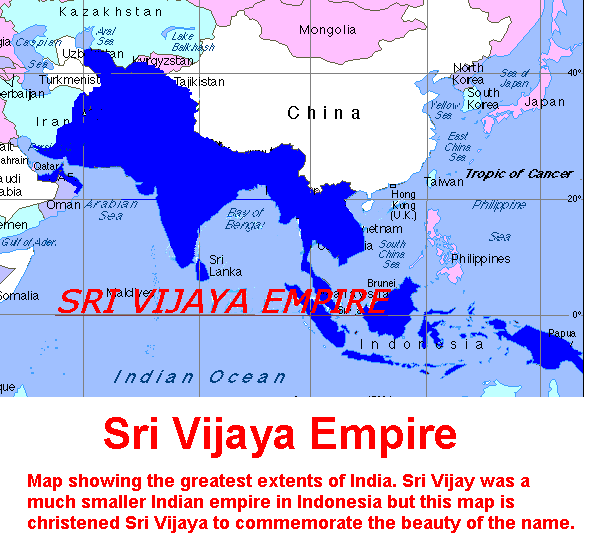Indian Art

Author: NOVO
E-mail: [email protected] 27th July 2000
Brief Introduction To The History of India
|
Learn Indian History Through Quotes |
Age Of Civilization |
Age Of Empires |
| Pre-Gupta |
| Gupta |
| Post-Gupta |
| Age Of Darkness |
| Mogul Era |
| Post-Mogul |
| Age Of Revolution |
| 20th Century |



Ancient India's Contribution To The World
Age Of Civilization: 5000 - 1500 BC
The Indus or Swarasvati Sindhu civilization was the largest of the four ancient urban civilizations which include China, Egypt and Sumeria. The civilization grew along the rivers Sindhu (mispronounced as Indus) and River Swarasvati. This region is mainly in present day India and Pakistan with some settlements and colonies in Afganistan, Iran and even Saudi Arabia. Its roots go back to 5000 - 3200 BC with the proto-city/village settlements and reached climax in the period 2600 to 1800 BC. Note: These dates have been prescribed by the west and are disputed.
At its height there were over 1400 cities and towns and it was the largest trading and seafaring civilization. However, it died out suddenly and mysteriously. Nothing concrete is known about events leading to its demise. Some propose that shifting of rivers had forced them to shift as well. Others point to an even bigger event that might have overtaken the civilization. This suggestion arises since at the same time as the end of the civilization, nomadic indo-european, Sanskrit speaking peoples entered the Indo-Persian region (1800 - 1500 BC). This coincidence and some old Vedic references lead many to believe that the Indus civilization might actually have been destroyed by the invasion of the new peoples. In the Vedas there are references to Indrah, God of the Sanskrit people, destroying -Purs (cities) and driving away dark skinned shorter peoples away. The Indus people were Dravir (Dravidian) who were dark skinned shorter people. The Veda even mentions a city called Hariupiah. Interestingly the first city discovered in this ancient civilization was Harappa.
| North Indians (more Sanskrit descent) often use "ia" or "ya" when pronouncing Dravir double letters. The Dravirs pronouncing Sanskritic "ia" use double letters. For example, Sotto (truth) is pronounced Satya or Satia and Annay (wrong) is pronounced Anyay. The famous city Ayodhya, is pronounced Ajodhdha by Bengals (y and j are also interchanged). Hariupiah is probably the same as Harappa. Of course for truth the word Such is used more often. |
Not a lot is known about this grand civilization but it seems apparent that much of its culture has survived as modern Indian culture. This includes Shiva, yoga, meditation and pacifism; the Indus seems to have lacked war or even central rule and had amazing engineering capabilities. Excavations have produced beautiful artifacts, seals and writing samples which still puzzle archeologists and linguistic experts. The game of chess also might have been invented there.
Age of Empires: 1500 - 1000 AD
During this time the Aryans became Indianized and accepted the lifestyle of the locals. They settled down and became agricultural just as the Dravirs. Their religion also takes a significant change. They relegate their gods and accept Shiva who was a concept from the Dravirs. This fusion of culture and religion forms the nucleus of what evolved into the Hindu religion.
Very soon cities evolved once again and great empires come into existence. Of course it is likely that places like Bengal had cities earlier as is evidenced by the place names ending in -Purs that are scattered all over Bengal.
The first of the great empires to emerge, after the destruction of the old civilization, was the Kosala empire whose origin lies in mystery. Kosala was conquered by Magadha which was one of the early Aryan-Dravir synthesis centres. During this long period, The Age of Empires, great successive empires rose from Magadha to control all India and as far west as Tashkent (Taksha Khand) in Uzbekistan. Indian empires were also created in south east Asia of which the greatest was in Cambodia and Indonesia.
Age Of Darkness: 1000 - 1900 AD
Then came the British (late 1700s) who took India piecemeal by various schemes in a period covering over a century. Their rule introduced extreme harsh conditions in India and the regions which they occupied the longest are now the poorest in India. The British deculturised India and caused great harm to her economy. The richest lands in the world at one time like Bengal and Bihar became the poorest and most backward. India was de-industrialized to fund the industrialization of Britain.
The British rule is trademarked by great famines. Their rule ravaged India and created a pauper nation, however, the one good thing their rule did was that it broke the rule of the Muslims. Other Indian empires in East Asia were taken over by the French, Portuguese and Dutch and were equally ravaged and thoroughly deculturised.
Age of revolution: India 1900 - 1947 AD
Finally, the British were persuaded by international, economic and revolutionary pressures to give up India. The colonial rule of India ended in a bitter independence in 1947 with India being divided along religious lines. The British divided India into India and Pakistan. (Nepal, Bhutan, Burma, Sri Lanka, Maldives follow a different history at this point.) They handed India over to moderate leaders like Gandhi and Pakistan to Jinnah, who represented the rich Muslim landlords. The revolutionaries were left out.
Age Of Revolution: Bangla 1947-1971 AD
Then in 1971, 23 years later, after racist attempts at stamping out Bangla (Bengal) culture, the Pakistani government soldiers went on a genocidal rampage that lasted 9 months. The Pakistani government carried out the most systematic, centrally organized and most concentrated genocides in history. They killed 3 million unarmed civilians, targeting mostly the educated and the young men. Their goal, as stated, was to cleanse the nation of Hindus and educated men by which they wished to perpetuate their rule. Shamefully, their advisor, financier, and ally was the United States in this horrendous and forgotten episode of history. (This reminds one of the Indonesian history.)
Bangladeshi (East Bengal) University teachers and students, joined by the masses started a guerilla resistance which became a national liberation war and was later taken over by politicians and rebel army officers. The guerillas in some of the most courageous and spectacular battles defeated Pakistanis on different fronts taking over vast areas of Bangladesh (East Bengal).
Towards the last few weeks, Indian support for the guerillas was increased vastly. The Pakistanis declared war on India and brought India directly in the war. Indian forces with the guerillas overwhelmed the Pakistanis in a matter of weeks. Pakistan had counted on the US, their staunch ally and main supporter in the war to send their 7th naval fleet to come into Bangladesh to crush the guerilla revolution and the Indian forces. However, the US forces had to return from Bangladesh without firing a single shot due to international pressure and pressure from the people of USA. Thus in 1971, Bangladesh became another independent nation borne out of India. (Unfortunately, the independent Bangla governments were corrupt just as well and Bangla has remained a chaotic and poor nation.)
Today, India exists as the stump of a vast empire broken into many pieces, broken economically and in spirit. India and Pakistan are still teetering on the verge of war and the whole subcontinent is still a pauper nation which is being de-culturised even today through the media. The new government of India, even though considered Hindu extremist, might be good for bringing back her lost past. Of course, until corruption in the government, enmity, hatred and rivalry between the different Indian countries is eliminated, and the nations are reunified, India will never regain her past and continue to be a petty regional superpower or at best maybe a tyrannical superpower in the future.
|Feedback|
|India|
|Ancient|
|Majlish|Kashmir|NOVO1|NOVO2|NOVO3|
|HOME|

